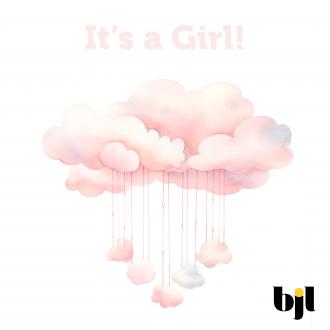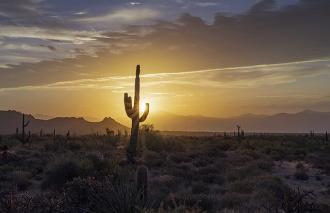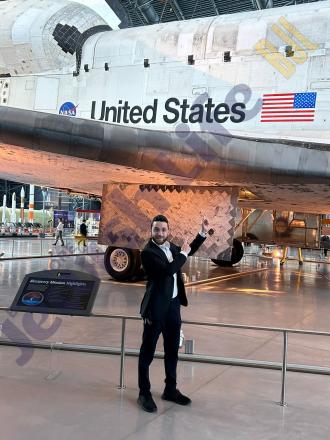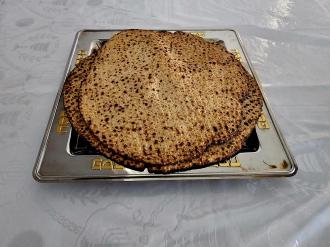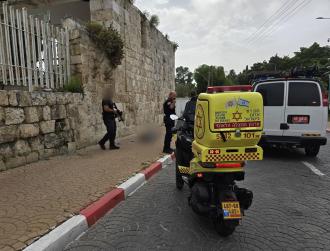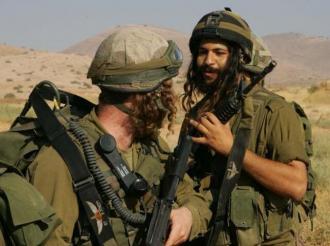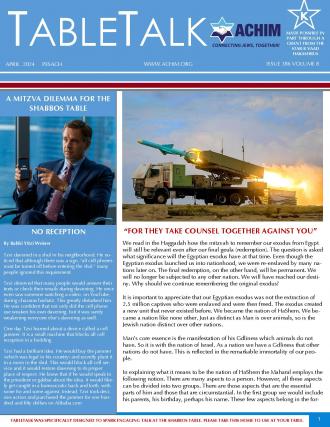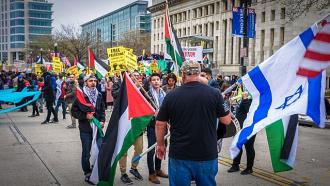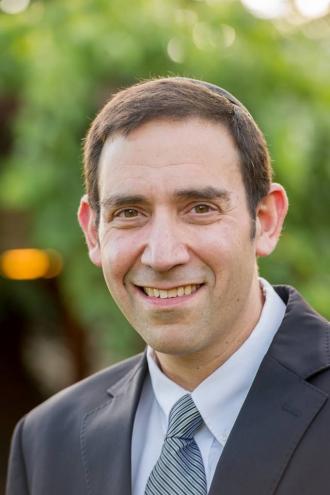Question #1: Trick
As a side parnasah, I perform tricks using ropes and knots. May I conduct a show during Chol Hamoed?
Question #2: Treat
May an indigent person work on Chol Hamoed in order to provide his children with treats for Yom Tov?
Question #3: Treasures
I discovered buried treasure on Chol Hamoed, and I’m afraid that if I wait until after Yom Tov someone else might find it. May I dig it up on Chol Hamoed?
Introduction:
Chol Hamoed is included among a very special category of mitzvos called osos – signs that that point out Klal Yisroel’s special relationship with Hashem. These signs include both positive and negative commandments. The positive ones include that Chol Hamoed should be noticeably different from ordinary weekdays; it should look like days in which we are celebrating – our dress and our meals should be clearly different from those of a weekday. The signs also manifest themselves in the delineation of which melacha activities are permitted on Chol Hamoed.
The authorities disagree concerning the extent to which dress on Chol Hamoed should be different from weekday garb. Some authorities rule that Chol Hamoed clothing should be on the same level as Yom Tov clothes, which are assumed to be fancier than those worn on Shabbos (Tanya, quoted by Magen Avraham 530:1). A second approach contends that it is sufficient that what one wears on Chol Hamoed is on the same level as Shabbos clothes (Magen Avraham 664:3). A third approach, that of the Mishnah Berurah (Shaar Hatziyun 530:4), concludes that Chol Hamoed dress should be nicer than weekday clothing, but does not have to be as nice as Shabbos clothes.
Melacha on Chol Hamoed
The Gemara (Chagigah 18a) implies that working on Chol Hamoed may be forbidden min haTorah, and this is the halachic position of many rishonim (see Biur Halacha530). Nevertheless, the majority conclude that the prohibition to work on Chol Hamoed is only a rabbinic ordinance. These authorities contend that the allusion in the Torah is not a drosha, that would make it an obligation min haTorah, but an asmachta, a hint, which is not a requirement min haTorah (Tosafos, Chagigah 18a s.v. Cholo). To quote the Rambam, “Notwithstanding that the Torah did not say, in regard to Chol Hamoed, ‘Cease from working,’ since it is called mikra kodesh and it is the time when the festival korban is offered in the Beis Hamikdash, it is prohibited to perform on it melacha, so that it should not be like the other weekdays that are not at all holy” (Hilchos Yom Tov 7:1). He then emphasizes that the prohibition is rabbinic.
Whether the prohibition of melacha is min haTorah or only miderabbanan, the purpose of Chol Hamoed is to devote one’s time to learning Torah (Yerushalmi, Moed Katan 2:3).
The laws of Chol Hamoed are often unclear. Since it is part of Yom Tov, many melacha activities are forbidden. On the other hand, activities that enhance the celebration of Yom Tov are usually permitted. What makes the laws of Chol Hamoed even more unusual is that there are activities that are permitted, such as some types of tzorchei rabbim, communal needs, despite the fact that this work actually decreases the spirit of Yom Tov. Chazal permitted communal needs to be performed on Chol Hamoed (Mishnah Moed Katan 2a), even when there is no Yom Tov need, even when it involves specialized, professional skills, and even when it is a major effort that will impact negatively on the celebration of Yom Tov. For example, it is permitted to mark graves or to pull out kelayim on Chol Hamoed, both of which are projects for which the community is responsible (Mishnah Moed Katan 2a). The reason this work is permitted is because these projects require availability of labor, and people are off from work on Chol Hamoed.
The Gemara itself notes that the halachos of Chol Hamoed are difficult to categorize, calling these laws akuros ve’ein lemeidos zu mizu (Moed Katan 12a), which Rashi explains to mean: like a barren woman (akarah), there is no “fruit.” This is an unusual way to say that one law of Chol Hamoed may not be compared easily to a different one – you cannot usually derive a “fruit,” an analytic conclusion, from one category to another. Even categories of melacha that are permitted contain subheadings that are not permitted, and creating clear, general rules is extremely difficult. Please note that, because of space restraints, I am providing only some background to the laws of Chol Hamoed and not a comprehensive work on its laws.
The poskim categorized the rulings of the Mishnah and Gemara, concluding that several types of work forbidden on Shabbos are permitted on Chol Hamoed. These include:
Davar ha’aveid
One of the categories of melacha permitted on Chol Hamoed is called davar ha’aveid, which means that not performing this activity could potentially cause financial loss. In general, this is permitted, provided that no excessive exertion is involved. The reason Chazal permitted this is because otherwise someone might worry about his loss and thereby spoil his enjoyment of Yom Tov (Ritva, Moed Katan 13a). However, working very hard – what I called here “excessive exertion” – would spoil the Yom Tov spirit to a greater extent than his worry does, which is why it is forbidden.
The case of the Mishnah that reflects this principle is a field that does not receive sufficient rainfall and, therefore, requires irrigation. If this field was planted and irrigated before Yom Tov, it may be watered from a natural spring, but not from rainwater (Mishnah Moed Katan 2a). The difference between a spring and rainwater is that the latter requires far more exertion than simply directing the water flowing naturally from the spring to your field. Hoisting buckets of water, which is usually the case when using rainwater to irrigate a field (and is sometimes the case when using a spring, is prohibited on Chol Hamoed, because this involves excessive exertion (see Mishnah Berurah 537:7).
The Mishnah implies that it is permitted to irrigate only a beis hashalchin, a field that requires irrigation, but not a field that receives adequate rainfall for its crops to grow (Shulchan Aruch, Orach Chayiim 537:1). Why would you irrigate a field that receives adequate rainfall? Because even such a field produces better crops when it is irrigated. This is prohibited on Chol Hamoed, since this is not considered preventing a loss, but providing greater profit, which is not permitted (ibid.). We will return to this principle later in this article.
Here is another type of davar ha’aveid that Chazal permitted on Chol Hamoed. The Gemara (Moed Katan 10b) states that doing even a small amount of business is prohibited on Chol Hamoed. Nevertheless, Rav Pappa ruled that someone who has more dates than he can sell as fresh produce may slice open the dates and press them out to dry on Chol Hamoed, even though they will certainly not dry quickly enough to be eaten on Yom Tov. The activity of drying them is permitted because of davar ha’aveid, since the dates may get wormy if he does not begin the drying process when the fruit is ripe.
Tzorchei hamoed
Chazal permitted making and repairing items on Chol Hamoed that will be used to enhance the Yom Tov atmosphere, provided one does not use a skilled method (maaseh uman) to manufacture or repair them. For example, someone who is not skilled in sewing may repair a garment that became torn on Yom Tov, so that it can be worn on Chol Hamoed (Moed Katan 8b, 10b).
Here are some more unusual cases of tzorchei hamoed that later authorities mention: You may tune an instrument in order to play it on Chol Hamoed, if doing so requires no specialized skills (Shu’t Shevus Yaakov 1:25). Similarly, it is permitted to swat mosquitoes if they are bothering you (Shu’t HaRadbaz #727).
Po’eil she’ein lo mah le’echol
Literally, this means a worker who is so poor that he has nothing to eat. Such a person my work on Chol Hamoed. But is this to be taken literally, i.e., that he has nothing at all to eat, or does it mean that he does not have enough to celebrate Yom Tov properly? This is a dispute between the Magen Avraham (542:1) – who contends that it means that he does not have even bread to eat and water to drink on Yom Tov, but if he does, he cannot work on Chol Hamoed – and the Lechem Mishneh (as quoted by Elya Rabbah 542:3), who explains it to mean that he does not have enough to celebrate Yom Tov properly.
Tie yourself in knots
At this point, we can begin to address our opening question: “As a side parnasah, I perform tricks using ropes and knots. May I conduct a show during Chol Hamoed?”
Several issues require clarification. If the entertainer is so poor that he qualifies as a po’eil she’ein lo mah le’echol, he is permitted to perform his show, and people are doing a mitzvah when they attend. If he does not qualify, we have to research whether any halachic issue is involved when tying specialty knots on Chol Hamoed.
Knotty question
Is there any prohibition against tying knots on Chol Hamoed?
The Gemara (Moed Katan 2b) mentions that melacha is prohibited on Chol Hamoed, because it is tircha, work that takes away from the appreciation of Yom Tov. Does this mean that it is permitted to do melacha that does not involve strenuous activity? One very prominent acharon, the Elyah Rabbah (533:4), indeed rules this way.
Based on the comments of several rishonim, the Beis Yosef (Orach Chayiim 540) rules that if your house has a dirt floor and you discover on Yom Tov that the dirt floor has a bump, you may remove the earth creating the bump from the floor on Chol Hamoed. The Beis Yosefwrites that even though smoothing a bump constitutes an activity that is prohibited min haTorah on Shabbos and Yom Tov (Shabbos 73b), it is permitted on Chol Hamoed because it is not a strenuous activity. This implies that you may remove the dirt lump from your floor on Chol Hamoed, even if it does not accommodate any Yom Tov need – for example, if you notice the bump as you are leaving the house on Chol Hamoed and are not returning until after Yom Tov. We could then conclude that non-strenuous activity is permitted on Chol Hamoed, even when it is a melacha and has no Yom Tov purpose.
This would mean that our rope showman may perform his activities on Chol Hamoed, even if they involve tying knots in a way that would be a melacha min haTorah on Shabbos and Yom Tov.
Several early halachic authorities seem to support this approach. For example, Tosafos (Moed Kattan 10b s.v. Prakmatya) rules that it is permitted to lend money with interest to non-Jews on Chol Hamoed. (It is forbidden min haTorah to charge Jews interest because of the prohibition of ribis.) Although the Gemara prohibits business activities on Chol Hamoed, this means transporting merchandise to the market or opening your store, both of which involve a great deal of tircha (Sefer Yerei’im). Lending money simply means keeping track of your records and making sure that the collateral you receive is sufficient to sell easily for the value of the loan.
For this reason, some recent poskim permit purchasing and selling stocks, bonds and commodities on Chol Hamoed (Debreciner Rav, quoted in Chol Hamoed, page 91). (However, this work also quotes a psak of Rav Moshe Feinstein that purchasing and selling stocks, bonds and commodities is prohibited on Chol Hamoed.)
Melacha versus business
It is possible that the rishonim who permitted lending money on Chol Hamoed did so only for business activities that do not involve any melacha actions. However, a melacha activity not for the purpose of enhancing the enjoyment of Yom Tov is prohibited, even when it does not involve any tircha. This appears to be the position of the Pri Megadim, who permits removing earth from a dirt floor only when necessary for Yom Tov (Eishel Avraham 540:5, 7). In other words, the Pri Megadim disputes the ruling of the Elyah Rabbah and permits a non-strenuous act only when there is a Yom Tov benefit.
The Chayei Odom seems to have held a similar approach to that of the Pri Megadim, since he forbids tying knots on Chol Hamoed, unless there is a Yom Tov purpose in doing so (Klal 110:11). This ruling would put our rope entertainer out of business on Chol Hamoed, unless his show fulfills a Yom Tov purpose, or if he limits his knots to those permitted to be tied on Shabbos.
It appears that this issue, whether non-strenuous melachos may be performed on Chol Hamoed when they do not fulfill a Chol Hamoed purpose, can be traced to a dispute among early acharonim. The Hagahos Maimoniyos (Hilchos Yom Tov 8:9) cites that the Maharam of Rottenberg prohibited tearing grass out of the cemetery on Chol Hamoed. This is quoted by the Shulchan Aruch and accepted as normative halacha (Shulchan Aruch Orach Chayim 547:12). But what exactly did the Maharam prohibit?
According to the Maamar Mordechai, the Maharam is referring to the common custom of pulling up some grass from the cemetery after a burial. The Maharam prohibited this on Chol Hamoed, because, although this involves no strenuous activity, it does not fulfill any Yom Tov need.
On the other hand, several prominent halachic authorities understood that the Maharam meant to ban something very different – mowing the grass on the cemetery property on Chol Hamoed, which is clearly a strenuous activity that does not serve a Yom Tov purpose. These authorities permit pulling up grass after a Chol Hamoed funeral the way it is usually done on other days of the year (Shu’t Mabit #250; Elyah Rabbah). We should note that the Elyah Rabbah is consistent in ruling that something non-strenuous is permitted on Chol Hamoed, even when there is no tzorech hamoed; the Maamar Mordechai agrees with the Pri Megadim that you cannot remove a dirt clod from the floor on Chol Hamoed, unless it is for a Yom Tov purpose, and also with the Chayei Odom, who prohibits tying knots if it is not a tzorech hamoed.
We could also, perhaps, prove that another earlier authority also held this way. The Radbaz, who lived in the fifteenth and sixteenth centuries, was asked whether it is permitted to swat mosquitoes on Chol Hamoed, when they are not bothering you. He rules that if the mosquitoes are not bothering you at the moment, it is forbidden (Shu’t HaRadbaz #727). Although swatting a mosquito is not a strenuous activity, the Radbaz prohibits it if it does not serve a Yom Tov purpose. This would appear to indicate that he also agrees that melacha that has no tircha is prohibited on Chol Hamoed. On the other hand, it would seem that the Mabit and the Elyah Rabbah, who permit pulling grass not for the purpose of Yom Tov, hold that melacha that involves no tircha is permitted on Chol Hamoed.
Buried treasure
At this point, let us discuss our third question:
I discovered buried treasure on Chol Hamoed, and I’m afraid that if I wait until after Yom Tov someone else might find it. May I dig it up on Chol Hamoed?
We noted above that it is permitted, at times, to perform melacha on Chol Hamoed in order to avoid a loss, but not in order to increase profits. This treasure is categorized as increased profit, for which performing melacha is prohibited on Chol Hamoed. So, this case should be treated the same as if you found treasure on Shabbos or Yom Tov -- you must wait until after Yom Tov to dig it up.
Conclusion
Four mitzvos of the Torah are called os, a sign of Hashem’s special relationship with us: Bris Milah, Shabbos, Yom Tov (including Chol Hamoed) and Tefillin. Because Chol Hamoed is included in this very special category, Jews should treat Chol Hamoed with great respect. Indeed, the Gemara states that disregarding the sanctity of the Yomim Tovim, including Chol Hamoed, is like practicing idolatry (Pesachim 118a with Rashbam). Some commentators explain that this includes even someone who fails to serve special meals in honor of Chol Hamoed (Bartenura, Avos 3:11). By observing Chol Hamoed properly, we demonstrate that we recognize and appreciate this special relationship between Hashem and Klal Yisroel.

